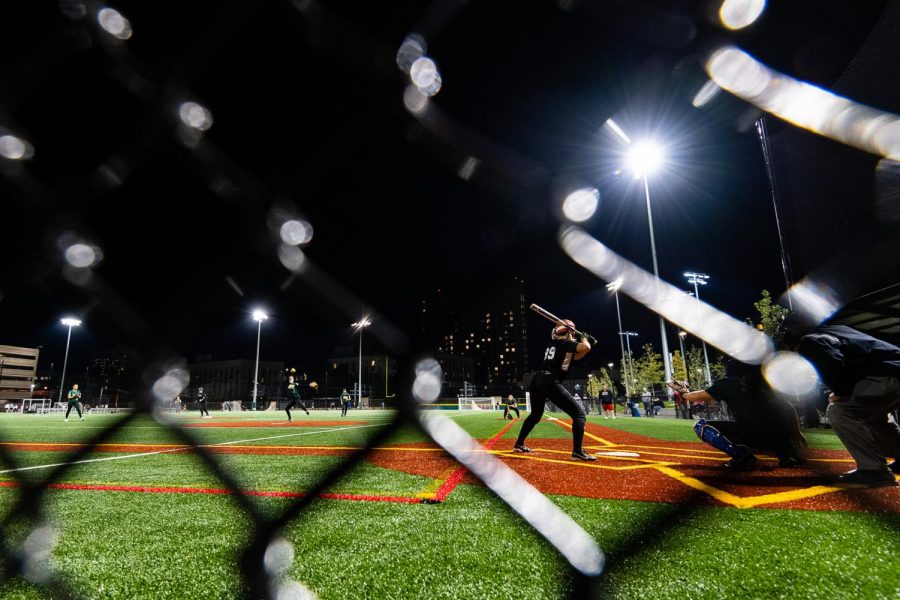Club Sports works to strike a difficult funding balance
Club softball, one of Northeastern’s “more successful” club sports, during a game last year.
October 16, 2019
Northeastern is home to 57 club sports teams, ranging from water polo and cricket to rock climbing and soccer. Each of Northeastern’s club sports teams receive money and support from the university, though the amount varies from sport to sport.
According to Nick Avery, associate director of Club Sports and Esports at Northeastern, every team receives an initial allocation of $1,500 once the team is an approved, active club. In addition, each team receives a roster allocation that is scaled year-to-year and based on the number of participants per team. According to Avery, the allocation is scaled so teams with larger rosters often end up with a smaller per-person allocation. This is to prevent “roster inflation,” or teams making their rosters bigger in order to receive more money.
“A lot of teams, like basketball, with smaller rosters, actually have a larger per person ratio for the allocation then a team like club ultimate with a team of 150 plus [people],” said Avery. “If we only based it on roster size it could encourage inflated rosters, which would defeat the purpose.”
Although this means teams are not receiving equal amounts of money, Hannah Nadeau, a fourth-year business administration major and president of the women’s club lacrosse team, said she feels the system is fair. “Club sports does team allocations based on number of people on each team, which is definitely a fair method,” she said.
However, some students feel like teams who have been more successful in past seasons receive more love from club sports.
“The more successful teams like girl’s softball seem to get more recognition from the club sports faculty,” said Brian Fields, a fourth-year political science and international affairs combined major and member of the club water polo team.
Julia Dextradeur, a third-year bioengineering major and member of the club gymnastics team, agreed. “I will say that the club sports office tends to give more help financially and tries to promote more club sports that are competitive relative to other schools,” she said. “Gymnastics has found that we get allocated more money for nationals than in previous years because we qualified to finals.”
The feeling that more successful sports receive more financial support is not unfounded. All teams who attend nationals receive a nationals allocation, according to Avery. But those teams that qualify receive more money than teams who elect to go to nationals even when they have not won enough games to qualify.
“Teams that qualify for their nationals, teams that win their regional for example, would receive the highest amount of national allocation per person,” Avery said. In this case, the allocation is per-person, meaning some teams receive a higher total amount of money, but every individual receives the same amount.
Teams who elect to go to nationals despite their record also receive funding. However, according to Avery, since this process is a little more open, “they don’t receive as much as the qualifying teams do.”
According to Avery, allowing teams like club basketball to use campus facilities can save teams anywhere between $10,000 and $50,000 a year. For clubs like gymnastics, which holds practice off campus, the club sports office offers facilities allocations, “supporting on average at least 90% of those expenses, for many teams 100 percent of those expenses,” Avery said. The club gymnastics team, a team that holds nearly all practices off campus, confirmed this.
When it comes to choosing practice times, “in-season teams will receive the nod over out of season teams so for example, lacrosse in the spring will get preference of their practice time since they are in season,” Avery said.
Avery demonstrated the complexity of scheduling practices with an anecdote about an activity he did at the Club Sport training. He asked the teams present to raise their hands for what practice times they were interested in, offering early morning, weekend and late night practices. No students raised their hands for any option except Monday-Thursday 6 p.m.-9 p.m., he said.
“Getting to know each team extensively is crucial to the allocation process of field times,” Avery said, addressing the difficulties he has encountered while scheduling practices. “For example, some teams will preference full field practices versus location, others will preference location vs. time and some factor amount of time, others factor in start time, others factor number of practices per week.”
Students did note that even when money and field times were allocated equally, some teams may receive more attention from club sports.
Dextradeur said sports with popular Division I teams seem to get more attention. “Since hockey is one of our main sports at Northeastern, sometimes I feel like the club hockey team gets more opportunities,” she said.
Fields agreed. “I think teams that get more interest from prospective members seem to receive more love.”
Nadeau also acknowledged that while more successful teams may garner praise, that does not impact the way those teams are treated. “They also give praise to teams that perform well in their league … but this praise does not equate to privileged treatment,” she said.







